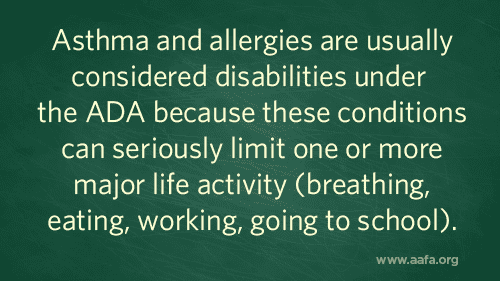Asthma
Asthma, Allergies, and the Americans with Disabilities Act (ADA)
Has a preschool rejected your child? Or was your child left out of a field trip because a teacher was afraid to use an epinephrine auto-injector? Does a moldy carpet at work or school make you sick? Does stale smoke in offices, hotel rooms or conference centers make it hard for you to work?
The ADA borrows from Section 504 of the Rehabilitation Act of 1973. The Rehabilitation Act says agencies, programs and services that receive federal money cannot discriminate based on disability when it comes to jobs or education.
This includes public accommodations, such as:
- Restaurants
- Hotels
- Theatres
- Stores
- Doctors’ offices
- Museums
- Non-religious private schools
- Child care programs
These places must be accessible to and usable by those with disabilities. No one can be left out or denied services because of a disability. They also cannot be left out due to ignorance, attitudes or stereotypes others may have about disabilities.
closed
Does the ADA Apply to People with Asthma and Allergies?
Major life activities include:
- Breathing
- Eating
- Working
- Going to school
In 2008, the ADA was changed to include more people in the definition of “disabled.” Conditions that only show symptoms at certain times are now included. Asthma and allergies fit this definition. The ADA protects people with asthma and allergies even if reactions or attacks happen only when triggered. The ADA can help to create an environment where patients can avoid their triggers.
Also, use of medical aids or devices can no longer exclude them from ADA coverage. For example, it used to be that people with asthma who got relief from an inhaler were not covered by the ADA. The inhaler was thought to have removed the disability. With the 2008 changes, the ADA covers people with asthma and allergies even if medication controls their symptoms.
How Does the ADA Work?
In most cases, everyone works together to improve conditions and promote equal access and include those with disabilities. This is called an accommodation. Accommodations are made on an individual basis because the needs of each person vary depending upon the situation.
 Examples of accommodations could include:
Examples of accommodations could include:
- Reorganizing work spaces to reduce odors
- Restricting the use of allergens in classrooms
- Removing old carpet
But an organization does not have to make an accommodation that causes an “undue burden” or that would create a “fundamental alteration” to its program. One example of an undue burden might be a small business without the money to cover the extra costs of an accommodation. Some accommodations may impact a company’s ability to do business, resulting in a major change. An organization must make a good faith effort to find and make acceptable changes. Organizations can refuse to make accommodations only after they have considered all options. Finding what works may require creative thinking and flexibility.
Making the ADA Work for You
If you or your child would like help due to asthma or allergies, speak with a school administrator, manager, employer, human specialist or disabilities service coordinator. They should know the procedure to help you get appropriate changes, aids or services. You can call on a variety of sources for advice and creative, practical ideas.
The U.S. Department of Justice (DOJ) runs a hotline where you can ask questions, get free materials and find out how to file a complaint. The ADA Hotline number is 800-514-0301 (voice) or 800-514-0383 (TTY). There is also helpful information about the ADA on their website at www.ada.gov.
Don’t Be Afraid to Speak Up
The ADA prohibits retaliation, harassment or coercion against people who exercise their rights or assist others in doing so. You may file a complaint with the DOJ if you feel you have been treated unfairly. The DOJ can sue to seek money damages and civil penalties in cases of general public importance, or where there is a “pattern or practice” of discrimination. You can find a list of all government agencies that handle ADA complaints at http://www.ada.gov/investag.htm.
You can also file a private suit to get a court order requiring a business or program to make necessary changes and possibly to pay attorney’s fees. You might also be able to get your job back and get back pay.
Let us work together to promote positive attitudes and safe environments for those with asthma and allergies. We can help fulfill the promise of the ADA for ourselves and our children.

Knowing how to manage asthma is important for better health and quality of life. We offer an online course called ASTHMA Care for Adults. This comprehensive program covers a full range of topics everyone with asthma needs to know. This self-paced online course is presented in different formats, such as videos, animations, handouts and more.












